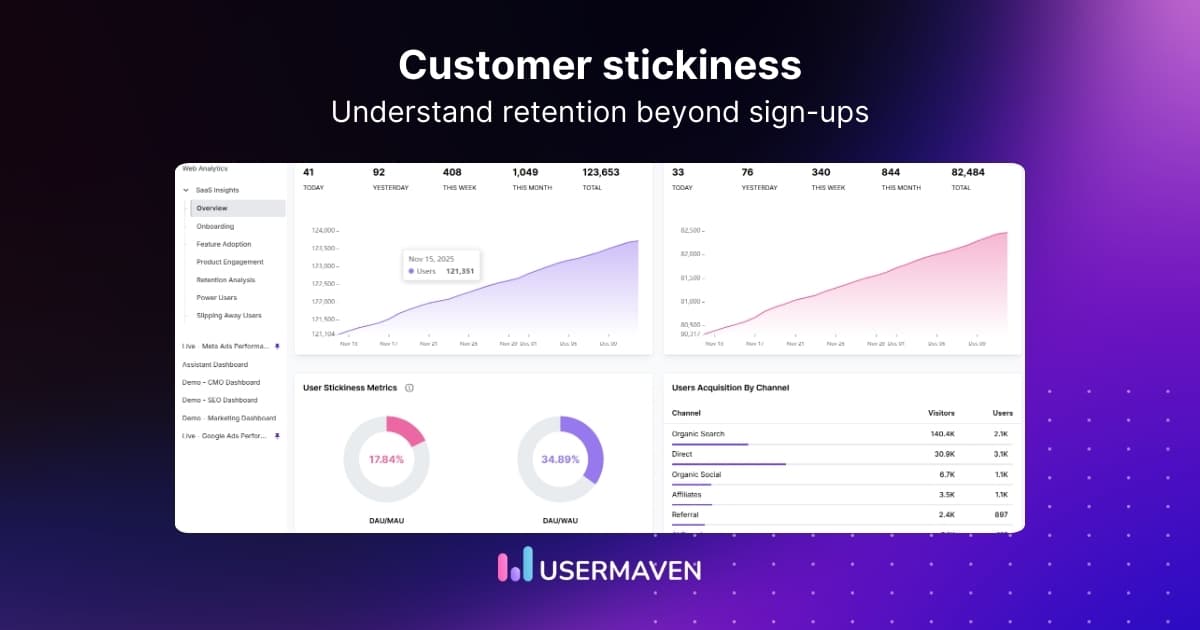Product updates march 2021: Attribution insight, events view and more!
Apr 5, 2022
2 mins read
Written by Usermaven

Welcome to the Usermaven release notes. Moving forward at the end of each month, we’ll share what new product updates are done in Usermaven.
1) Attribution insight
We have released a new report template under the Acquisition module named “Attribution”.
Put simply, marketing attribution is the quantitative analysis of determining which marketing tactics contribute to sign-ups, sales or conversions.
This report will provide insights to know which marketing channels and sources are performing well for your product by analyzing customer journeys using 4 different types of attribution models.
To get started with the attribution insight, head over to the ‘Acquisition’ module in the Usermaven dashboard and click on ‘Manage Insights’. Then, use the ‘Attribution’ template provided to setup your first attribution insight.
In the next step, give it a name and select your conversion event usually the sign-up event. Optionally, you can exclude certain referrer traffic from attribution by using the ‘Exclude referrer’s traffic’ option. This may come in handy when you’d want to exclude any internal traffic such as docs.website.com.
That’s it. You’ll see the marketing channel’s performance breakdown based on the attribution model
Which attribution models are available?
We have four attribution models that you can use to analyze your marketing channels’ performance and spot the best sources.
First touch
The first touch attribution model gives 100% of the credit for a conversion to the source of first click or visit of a converted user.
Last touch
The Last touch attribution model gives the credit entirely to the source of the final touchpoint before the conversion.
Linear
Linear attribution is a multi-touch attribution model that evenly distributes conversion credit across each touchpoint. Put simply, this attribution model assigns a participation credit to each marketing channel used before the conversion.
Position decay
The position decay is a multi-touch attribution model that employs an algorithm that assigns points to all the traffic sources in the reverse order. The last touchpoint is very important and gets the highest score, and the score decreases progressively for each traffic source until it reaches the first touchpoint.
2) Events page
We’ve added a new page for custom events that you are passing from your product to Usermaven. You’ll be able to see the total number of events triggered, first occurrence, last occurrence and pulse to see if the events are firing as they should.
Mute events
Some of the custom events you passed to Usermaven may not be relevant anymore at a later stage or you may have passed some wrong events. So, you can mute those events to lessen the noise using this option from Custom Events.
Muted events will no longer be available during Insight setup and on the Dashboard events section.
Events activity
To see all the events that are tracked by Usermaven from your product/website, you need to go to the Events Activity page. This is especially helpful to see if the events are firing as they should while you are integrating Usermaven with your product.
View event properties
You can click on an event from the events list to see the properties that come along to provide more details regarding the action performed.
Failed events
It is important to know if any events are failing because of incorrect data passed to Usermaven. Click on the “Failed Events” option, and you’ll see a list of failed events with an error message if there’s any.
3) React & next examples
We have added instructions and examples for React.js & Next.js for making the integration process easier. If your product is using any of the above frameworks, you can see the examples inside your account to get started.
Power up your SaaS
with perfect product analytics
*No credit card required
Coming up next
In the next few weeks, we’re excited to be working on the following updates for you:
- Automatic event tracking from your product using Autocapture technology. Also, you’ll be able to group multiple auto captured events and use them in the insights.
- Ability to segment a group of users who meet a specific rule, or set of rules. Segments will allow to filter users meaningfully with multiple conditions, and identify users who have (or haven’t) taken important actions inside the product.
- SDK for web and mobile applications.
- And much more exciting stuff.
We’re always looking to make your experience of using Usermaven better. We’ll keep you updated as we ship more improvements. If you’d like to request a new feature, please follow this link.
Join our Facebook community of product people to learn how you can improve adoption and reduce churn in your business.
Try for free
Grow your business faster with:
- AI-powered analytics & attribution
- No-code event tracking
- Privacy-friendly setup


